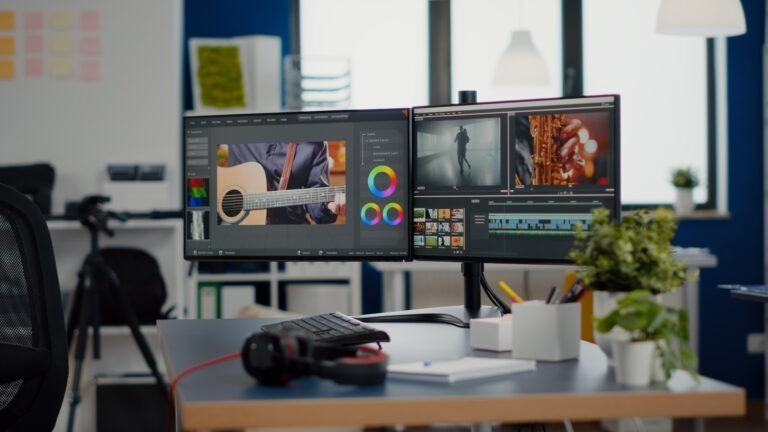Are you racking your brain for out-of-the-box corporate video production ideas? In today’s fast-paced media jungle, the pressure is on to create corporate video content that’s impressive and memorable. Something that gets audiences hitting ‘replay’ like it’s the latest viral cat meme.
Now, at Voice123, we understand that video has a special place in business – whether it’s corporate video production or corporate training videos. So, in this post, you’ll find the insights you need to spark your creativity as we examine what is a corporate video and how to make one, as well as their optimal length and a few pros and cons of corporate training videos and corporate video production companies.
Are you ready to go to corporate video infinity and beyond?
What is a corporate video?

A corporate video is an informational video that companies and organizations use to showcase their brand identity, history, values, products, and services. These videos work for marketing or educational purposes to engage target audiences and convey specific company messages. Corporate videos are available in animated, live-action, 2D/3D graphics, or whiteboard animation formats.
For example, a multinational tech corporation’s video can demonstrate the practical applications of its technology in various industries. At the same time, a financial institution can use its corporate video to communicate its values, history, and commitment to customer service.
So, now that we know what these videos are let’s look at how to make a corporate video.
How to make a corporate video
- Define your objectives and audiences
- Write the storyboard and script
- Conduct pre-production planning
- Use different video film options
- Hire professional voice actors
- Distribute, track, and optimize
1. Define your objectives and audiences
Start your video with a purpose; is it a brand promotion, a product launch, or something for internal communication? Then, identify the target audience—are they customers, investors, or employees? For example, Nike’s Dream Crazy campaign with Colin Kaepernick focused on inspiring and empowering audiences while addressing societal issues. The video effectively targeted a socially conscious demographic, aligning with Nike’s brand values.
2. Write the storyboard and script
When creating your storyboard, outline the visual sequences and narrative flow. Then, develop an exciting script that aligns with the video’s objectives so it resonates well with audiences. In Airbnb’s We Are Here video, each storyboard panel delineated scenes depicting travelers interacting with locals, experiencing unique stays, and forming meaningful connections. If you’re looking for the latest writing techniques to inspire your storyboard, check out our post on Video Script Templates.
3. Conduct pre-production planning
Focus on logistics like locations, props, actors, and equipment, and schedule shoots, rehearsals, and interviews. And always factor in enough time for delays in transport and location filming. Coca-Cola’s Share a Coke campaign is one example of extensive planning. The company needed personalized labels, strategic distribution, and user-generated content to produce a campaign highlighting consumers’ natural enjoyment of the product.
4. Use different video film options
To film videos, you can use 3 options. 1) An in-house video team, 2) a pro video production company, or 3) a freelance videographer. An in-house team offers convenience and easy communication; a professional company provides specialized equipment and expertise; and a freelance videographer is cost-effective for small-scale projects. Ultimately, the choice depends on project scope, budget, and production expertise. For example, Red Bull’s Stratos campaign filmed Felix Baumgartner’s record-breaking freefall jump from the stratosphere with an outsourced professional team. The top-notch equipment and personnel captured a moment that lives forever on film.
5. Hire professional voice actors
With professional talent like the voice actors on Voice123, you can ensure the vocal tone and style complement your video’s key visual elements. See, a voice over does more than just narrate on-screen images; it elevates the storytelling of a brand message while drawing global audiences. It can add sorrow, fun, quirkiness, lightheartedness, or deep emotion – whatever feelings resonate with your brand. Think of Rashida Jones’ voice over for Southwest Airlines. The company introduced “transfarency” for the first time, quickly becoming a buzzword. With a fun, vibey voice over, this campaign led to a record number of airline travelers the following year.
6. Distribute, track, and optimize
You can distribute your video through social media, websites, or email while tracking key metrics with analytic tools. These include views, engagement, and CTRs. To optimize your video’s performance, you should adjust the content, SEO, and formatting for different platforms. You can also implement promotional strategies if the video’s performance falls short in some aspects. For example, a tech company’s new software product video distribution can include LinkedIn, Twitter, and the company newsletter. The company can then track metrics like views, engagement, and click-through rates, which guide optimization and enhance reach and engagement.
How long should a corporate video be?
A corporate video should be between 2 and 3 minutes long; however, the optimal length depends on how a company balances its information and creativity with audience attention spans and interest. Other corporate videos, like promotional and product videos, are between 60 and 90 seconds, while company overview videos range from 1 to 3 minutes, training videos between 3 and 10 minutes, and HR videos between 1 and 5 minutes.
What are corporate training videos?
Corporate training videos are visual learning tools companies create to educate and train employees about company policies, product knowledge, safety procedures, soft skills development, compliance training, and more. These videos provide a structured, efficient way to deliver consistent content with easy accessibility and flexibility in learning schedules. They generally incorporate multimedia elements to enhance engagement and knowledge retention. These videos also integrate with training programs, onboarding processes, and ongoing professional development initiatives.
Now, let’s look at a few pros and cons of corporate training videos.
Pros of corporate training videos
1. Cost-efficiency
Creating a comprehensive training program through videos reduces costs associated with arranging physical training spaces, travel expenses, and printed materials. A company with a limited budget can produce one set of videos utilized in multiple training sessions across different locations.
2. Engaging learning experience
Incorporating engaging elements like animations, real-life scenarios, and interactive quizzes into videos captures employees’ attention better than traditional lectures. A safety training video with simulations of workplace incidents can effectively convey safety protocols and procedures, making the learning experience more immersive.
Cons of corporate training videos
1. Technological challenges
Poor internet connectivity or outdated devices can hinder access to training videos. Employees working remotely from an area with limited internet access might need help to stream high-quality videos, affecting their learning experience.
2. Inability to clarify doubts in real-time
If a concept in the video isn’t clear, employees might not have an immediate means to seek clarification. In a complex training video about financial procedures, employees might have questions that need quick clarification, which the video cannot provide.
What are corporate video production companies
Corporate video production companies create professional video content for the specific needs of businesses and organizations. They develop creative concepts by crafting scripts, storyboarding, and planning the logistics for filming, as well as focusing on conceptualization, filming, editing, and the final delivery of the video product. These production companies also employ skilled professionals like directors, cinematographers, editors, and other crew members who use high-quality equipment and techniques to capture footage, ensuring a polished and engaging final product.
Here are a few pros and cons of corporate video production companies
Pros of corporate video production companies
1. Expertise and professionalism
These companies specialize in video production, possessing a team of professionals with expertise in scripting, filming, editing, and post-production. They bring creativity, technical skills, and industry knowledge to ensure high-quality videos. A corporate video production company might have experienced scriptwriters who can craft compelling narratives that effectively communicate a company’s message or values.
2. Access to quality equipment and technology
Video production companies invest in high-end equipment and cutting-edge technology to produce top-notch videos. This includes cameras, lighting, sound equipment, editing software, and more. A corporate video production company might use advanced cameras and drones to capture stunning aerial shots or high-resolution footage for a promotional video.
Cons of corporate video production companies
1. Cost consideration
Professional video production services, especially for high-quality, customized content, can be expensive. The cost includes fees for equipment, skilled professionals, location rentals, post-production, and more. A startup company with limited funds might find it challenging to afford the services of a high-end video production company for their promotional videos.
2. Communication challenges
Miscommunication or differences in creative vision between the hiring organization and the production company can arise. This might result in delays, revisions, or a final product that doesn’t meet the client’s expectations. A discrepancy in understanding the brand message could lead to a video that doesn’t reflect the intended image or values of the company.
Final thoughts on corporate videos

So folks – corporate videos are more than just business clips. They’re tools that elevate your brand, engage audiences, and drive business success. By following our five key steps, you can make successful corporate videos – be sure to define your objectives and audiences, then write the storyboard and script, conduct pre-production planning, film the video, use professional voice overs to enhance the story, and appeal to consumers globally, and finally, distribute, track, and optimize your content.
Now that you know how to make awesome corporate videos, you can add a professional voice over to your videos to attract global audiences. And there’s no better place for pro vocal talent than Voice123. You can also leave your project with our skilled Managed Services, where our team handles the entire voice over project from start to finish.
So, now that you’ve got an arsenal of production skills, may the force of corporate videos be with you in your next media endeavor!
FAQs
Start with scriptwriting, storyboarding, and location scouting, then move on to shooting interviews, B-roll footage, and relevant content, and finally focus on post-production tasks like editing, adding effects, and sound mixing to create a professional video tailored to the company’s objectives.
Corporate videography is creating video content specifically for businesses or organizations. It involves capturing footage, interviews, events, or promotional content that showcases a company’s brand, culture, products, or services to its target audience.
They are corporate videos, marketing and promotional videos, training and educational videos, event coverage, and explainer videos.
On average, a simple corporate video might cost between $1,000 to $10,000. More elaborate productions with higher production values can range from $10,000 to $50,000 or more, depending on the project’s scope and quality expectations.



































































































